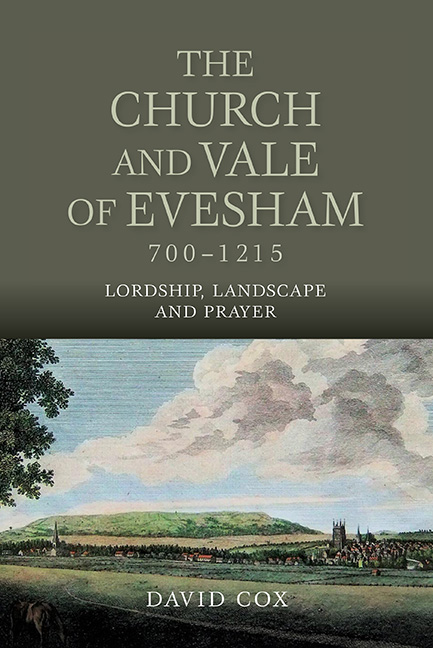Book contents
- Frontmatter
- Dedication
- Contents
- List of Illustrations
- Preface
- Timeline
- List of Abbreviations
- Part I From Minster to Abbey (701–1078)
- Part II Abbot Walter (1078–1104)
- Part III Twelfth-Century Themes (1104–1215)
- Afterword
- Appendix: The Abbots of Evesham to 1215
- Select Bibliography
- Index
- Miscellaneous Endmatter
7 - Abbot Ælfweard and King Cnut
Published online by Cambridge University Press: 11 May 2021
- Frontmatter
- Dedication
- Contents
- List of Illustrations
- Preface
- Timeline
- List of Abbreviations
- Part I From Minster to Abbey (701–1078)
- Part II Abbot Walter (1078–1104)
- Part III Twelfth-Century Themes (1104–1215)
- Afterword
- Appendix: The Abbots of Evesham to 1215
- Select Bibliography
- Index
- Miscellaneous Endmatter
Summary
IN 1016 Evesham's affairs were about to take a turn for the better. King Æthelred had enabled Abbot Ælfweard to retrieve control of the estates that Godwine had taken, and although Æthelred's support for Evesham came to an end with the king's death in April 1016, while the affairs of the kingdom were still in crisis, Godwine's claim on the abbey's estates was finally extinguished later that year when he was killed in battle against Cnut at Ashingdon in Essex. The battle, and the death soon afterwards of Æthelred's son King Edmund, resulted in Cnut becoming king of England and in a gradual return to relative peace and order. A succession of capable abbots and supportive kings would then give Evesham abbey decades of stability and, with it, the opportunity to prosper.
Cnut's reign began particularly well for Evesham because Abbot Ælfweard was already a kinsman (consanguineus) of the new king. The connection was probably through Cnut's first wife Ælfgifu of Northampton, an English noblewoman whom Cnut had married on an earlier expedition to England. It was presumably to Ælfgifu and not to Cnut that the English abbot Ælfweard was related by blood and it may be relevant to observe that the first element of the names Ælfweard and Ælfgifu was the same; that was the English custom among close relatives. If Ælfweard and Ælfgifu were related, both may also have become allied by marriage to Leofric, who was earl of Mercia by 1032, for Leofric's son Ælfgar seems to have married a kinswoman of Ælfgifu, perhaps in the late 1020s. When Cnut, as the abbey's royal patron, decided to place Evesham under the personal protection of the ‘Lady Ælfgifu’ some time before 1023 he may have been mindful that she had a family connection with the abbot. In any case, Ælfgifu of Northampton would have been a fair choice for the position. By 1023 Cnut had been married for some years to Emma of Normandy, his second wife, who was also known in England as Ælfgifu, but Cnut had never repudiated the first Ælfgifu; on the contrary, he continued to hold her in high regard and in 1030 entrusted her with the regency of Norway.
- Type
- Chapter
- Information
- The Church and Vale of Evesham, 700-1215Lordship, Landscape and Prayer, pp. 58 - 67Publisher: Boydell & BrewerPrint publication year: 2015

